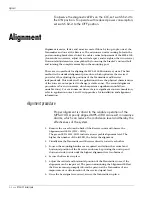
Do’s and Don’ts a planning primer
a - 4 • • • MPS-4100 product guide
The beam width also depends on the sensitivity setting of the receiver. The beam
width increases as the sensitivity is increased.
Physical limitations to the maximum beam width
Large metal objects such as vehicles, fences and buildings can
be detected well beyond the typical detection envelope. To
prevent nuisance alarms caused by nearby metallic objects,
reduce the separation distance (zone length) for microwave
zones that are close to any large metallic object.
When there is a physical limitation to the maximum size of the beam width, (for
example, when the microwave units are located between two parallel fences or
beside a single fence, near a vehicle storage area or parking lot, or close to
buildings) a variation of the beam width formula must be used to calculate the
maximum transmitter/receiver separation. In this case, measure the distance from
the beam centerline to the closest limiting object. Use this measurement as the
maximum allowable beam width. As a general rule, the clear area around the zone
should be twice the maximum beam width. The following formula can be used to
determine the maximum zone length that can be used when there is a physical
limitation to the microwave beam width:
zone length (max.) = BW (beam centerline to nearest limiting object) ÷ numeric
factor (product specific)
For example, if an MPS-4100 is being installed between two parallel fences that
are 6 m apart, the maximum zone length is calculated by dividing 3 m (distance
from beam centerline to fence) by 0.066 (MPS-4100 numeric factor), which equals
45 m. Figure a-6 illustrates a typical MPS-4100 zone length/detection pattern at 91
m, and the zone length adjustment that must be made for the same system if it is
installed between parallel fences that are 6 m apart. It is possible to increase the
length of this zone by reducing the microwave’s sensitivity setting. However,
reducing the system sensitivity also reduces its effectiveness.
Site Rules - DO’s and DON’Ts
•
DO use bistatic microwave sensors in clear, flat areas that provide a clean
line-of-sight. Bistatic microwave units are line-of-sight sensors that require
a reasonably long and flat detection zone.
•
DON’T use bistatic microwave sensors in areas where the line-of-sight will
be blocked, for example, in parking areas, where fixed objects are inside
the beam pattern (out buildings, guard shacks), where power or light
poles are in the direct center of beam.
Figure a-6 Reduced zone length between fences
1.5 m (5 ft.)
1.5 m (5 ft.)
3 m (10 ft.)
maximum beam width 3 m (10 ft.)
6 m (20 ft.)
fence
fence
Reduce the transmitter and receiver separation distance (zone length)
to provide good microwave detection coverage between 2 parallel
fences
without increasing the nuisance alarm rate.
Potential area where nuisance alarms may be caused by reflected microwave
energy if the beam width is too wide (inside diamond shaped box with dotted lines).
microwave zone between 2 parallel fences (6 m apart)
91 m (300 ft.)
unobstucted microwave zone
typical beam width = 6 m (20 ft.)
45 m (150 ft.)
Содержание MPS-4100
Страница 1: ...Product MPS 4100 Microwave Protection System Guide E6DA0102 003 Rev C Third Edition April 27 2009 ...
Страница 6: ......
Страница 70: ......















































